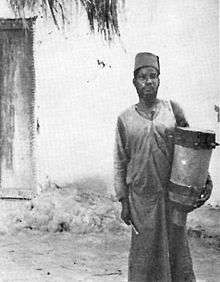Afro-Arab
Afro-Arabs are Arabs of Sub-Saharan African descent. These include the indigenous black populations within mainly the Sudanese, Egyptians, Moroccans, Algerians, Sahrawis, Mauritanians, Yemenis and Tunisians - but also some smaller black minorities among Palestinians, Jordanians, Iraqis, Libyans and the Gulf states.
| Regions with significant populations | |
|---|---|
| Middle East and North Africa Arab world, also East Africa Swahili Coast | |
| Languages | |
| Arabic, Teda, Comorian, Swahili | |
| Religion | |
| Islam, Christianity (minority) | |
| Related ethnic groups | |
| Afro-Iraqis, Al-Akhdam |
Overview

By around the 1st millennium AD Bantu fishermen established trading towns on what is now called Swahili Coast which between the tenth and twelfth century become Arabized. The Portuguese conquered these trading centers after the discovery of the Cape Road. From the 1700s to the early 1800s, Muslim forces of the Sultanate of Muscat reseized these market towns, especially on the islands of Pemba and Zanzibar. In these territories, Arabs from Oman and Yemen mingled with the local "negro" populations, thereby establishing Afro-Arab communities.[1] The Niger-Congo Swahili language and culture largely evolved through these intermarriages between Arab men and native Bantu women.[2]
Afro-Arab communities were similarly founded in the Nile Valley, as Arabs intermarried with indigenous tribes of Sudan.[3] However, many other Afro-Arabs in the Sudans had little biological connection to Arab peoples, but were instead essentially of Nilotic origins, albeit influenced by the old Arabian civilization in language and culture.[4] In the mid-to-late 1800s, Arab traders began to move into the central African interior, in pursuance of the ivory trade.[5] Unlike other cases of racial mixing, Arabs, mainly from the Persian Gulf, generally did not view Afro-Arabs as half-caste; Afro-Arabs instead enjoyed similar statuses in their societies as long as the father was Arab.[3] Thus, after the Zanzibar Revolution of 1964, many of the Afro-Arabs that left Zanzibar and settled in Oman were able to attain high political and diplomatic positions and be accepted as Arabs.[6] Racial assimilation of Afro-Arabs with non-Arab Africans also aided Muslim missionaries in the spread of Islam throughout Africa.[3] However, this is not the case for the Afro-Arabs of North Africa, whereas racial discrimination still plays a major role on segregating Afro-Arabs from mainstream Arab population, as found in Tunisia, Algeria, Libya and Morocco.[7][8][9][10]
In the Arab states of the Persian Gulf, descendants of people from the Swahili Coast perform traditional Liwa and Fann At-Tanbura music and dance.[11] The mizmar is also performed by Afro-Arabs in the Tihamah and Hejaz regions of Saudi Arabia. The ancestors of these Africans were originally brought to the Arabian Gulf as slaves. But today they are fully recognised citizens of the Persian Gulf States, despite the fact that they do not have any Arab ancestry.
In addition, Stambali of Tunisia and Gnawa music of Morocco are both ritual music and dances, which in part trace their origins to West African musical styles.
List of Afro-Arabs
- Omar al-Bashir, Sudanese politician
- Mohamed Timoumi, Moroccan footballer.
- Anwar Sadat, Egyptian politician.
- Hamza Mendyl, Moroccan footballer.
- Hatem Trabelsi, Tunisian footballer.
- Ali Ghazal, Egyptian footballer.
- Radhi Jaïdi, Tunisian footballer.
- Raïs M'Bolhi, Algerian footballer.
- Larbi Benbarek, Moroccan footballer.
- Amjad Kalaf, Iraqi footballer.
- Yacine Brahimi, Algerian footballer.
- Almoez Ali, Qatari footballer.
- Ayoub El Kaabi, Moroccan footballer.
- Yasser Larouci, Algerian footballer
- Moustapha Djallit, Algerian footballer
- Etab, Saudi Arabian Singer
- Roda Antar, Lebanese footballer.
- Abderraouf Zarabi, Algerian footballer.
- Messaoud Ould Boulkheir, Mauritanian politician.
- Abdelatif Bahdari, Palestinian footballer.
- Abdelhakim Omrani, Algerian footballer
- Zakarya Bergdich, Moroccan footballer.
- Abdallah Dghemaat, Jordanian lead actor in the feature film Fish Above Sea Level.
- Hadj Bouguèche, Algerian footballer
- Mohammed Hussein Al Amoudi, Saudi billionaire.
- Khalil Bani Attiah, Jordanian footballer.
- Akram Afif, Qatari footballer.
- Ali Afif, Qatari footballer.
- Bamba Müller, Egyptian mistress, wife of Duleep Singh.
- Djamal Mahamat, Libyan footballer.
- Saad Al-Salim Al-Sabah, Kuwaiti politician.
- Hicham Boudaoui, Algerian footballer.
- Jamal Taha, Lebanese footballer.
See also
Citations
- Hinde 1897, p. 2.
- Tarikh, Volumes 1-2. Longman. 1966. p. 68. Retrieved 6 December 2016.
- Mazrui 2014, p. 77
- Guarak 2011, pp. 7, 401.
- Hinde 1897, p. 3.
- Mazrui & Mutunga 2004, p. 324
- https://www.aljazeera.com/programmes/peopleandpower/2016/03/tunisia-dirty-secret-160316153815980.html
- https://www.laits.utexas.edu/africa/ads/900.html
- https://www.independent.co.uk/news/world/africa/libyans-dont-like-people-with-dark-skin-but-some-are-innocent-2345859.html
- https://www.bbc.com/news/world-africa-46810367
- Poul Rovsing Olsen, "La Musique Africaine dans le Golfe Persique", Journal of the International Folk Music Council, Vol. 19, (1967), pp. 28-36
References
- Guarak, Mawut Achiecque Mach (2011). Integration and Fragmentation of the Sudan: An African Renaissance. AuthorHouse. ISBN 9781456723569.CS1 maint: ref=harv (link)
- Hinde, Sidney Langford (1897). The Fall of the Congo Arabs. London: Methuen & Co.CS1 maint: ref=harv (link)
- Mazrui, Alamin M.; Mutunga, Willy, eds. (2004). Debating the African Condition: Race, gender, and culture conflict (illustrated ed.). Africa World Press. ISBN 9781592211456.CS1 maint: ref=harv (link)
- Mazrui, Ali A. (2014). The Politics of Gender and the Culture of Sexuality: Western, Islamic, and African Perspectives. University Press of America. ISBN 9780761864035.CS1 maint: ref=harv (link)
External links
- Arab Slave Trade Afo-Arab relations and the Arab Slave Trade
- "Black Africans in (Arab) West Asia" - a cited ColorQ.org essay
- Prof. Helmi Sharawy, Arab Culture and African Culture: ambiguous relations, paper extracted from the book The Dialogue between the Arab culture and other cultures', Arab League, Educational, Cultural and Scientific Organisation (ALECSO), Tunis, 1999.
- Resolution on Afro-arab Co-operation of The Council of Ministers of the Organization of African Unity, 23, February 23–28, 1987.
- African Union/league of Arab States Inter-secretariat Consultative Meeting On Afro-arab Cooperation, Addis Ababa: 10–12 May 2005.
- Maho M. Sebiane, « Le statut socio-économique de la pratique musicale aux Émirats arabes unis : la tradition du leiwah à Dubai », Chroniques yéménites, 14, 2007..
- Afro-Arabian origins of the Early Yemenites and their Conquest and Settlement of Spain